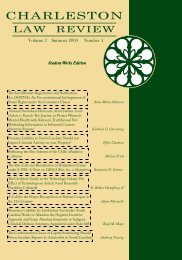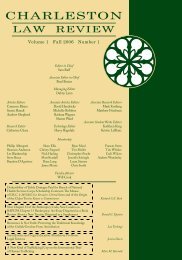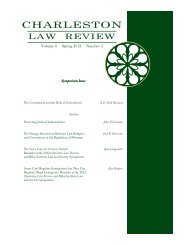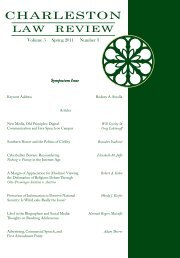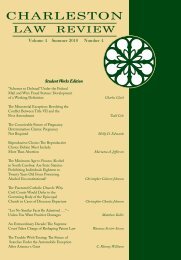Volume 5 Winter 2011 Number 2 - Charleston Law Review
Volume 5 Winter 2011 Number 2 - Charleston Law Review
Volume 5 Winter 2011 Number 2 - Charleston Law Review
You also want an ePaper? Increase the reach of your titles
YUMPU automatically turns print PDFs into web optimized ePapers that Google loves.
CHARLESTON LAW REVIEW [<strong>Volume</strong> 5legally insufficient. 224 Thus, the Chapter 7 trustee was notobliged to object to the debtor’s exemption of property withinthirty days after the meeting of creditors. 225As we study the holdings of the Court in both cases, itbecomes clear that the essential nature of each case is whetherthe party potentially obligated to file an objection was givensufficient notice to trigger their objection obligation. Espinosaclearly rests on the notice issue because its holding is based uponMullane, 226 in that the notice in Espinosa was reasonablycalculated under the circumstances to warn United to act. 227Schwab is not so clearly a notice case at first glance, but it comesinto focus with proper scrutiny. 228Initially in Schwab, the Court talks about the definition ofproperty being the key to the resolution of this case; that is,whether property is the “asset itself” or an “interest” in thething. 229 The question here must be asked: “Why does the Courtneed to define property?” The answer is so that the Court candetermine whether the trustee was put on fair notice that Reillywas intending to exempt the entire value of the property. So,while the Court is overtly discussing the definition of property, itis covertly laying the foundation to determine adequate notice. 230If the Court had agreed with Reilly that the property was thething itself, as opposed to the interest in the disputed thing, thenthe fact that Reilly claimed the exemption value and the currentmarket value to be identical would have been fair warning to thetrustee that Reilly was claiming the full value of the property asexempt. 231 However, because the Court describes the property asthe debtor’s interest, the property is now bifurcated into theamount the debtor can claim as exempt, which is all she isentitled to, and the balance of the current market value, which is224224. Schwab, 560 U.S. at ___, 130 S. Ct. at 2677.225. Id.226. Mullane v. Cent. Hanover Bank & Trust Co., 339 U.S. 306 (1950).227. Espinosa, 559 U.S. at ___, 130 S. Ct. at 1378.228. E.g., Schwab, 560 U.S. ___, 130 S. Ct. 2652.229. Id. at ___, 130 S. Ct. at 2659–64.230. Id. at ___, 130 S. Ct. at 2661–64.231. Id. at ___, 130 S. Ct. at 2660–61.



